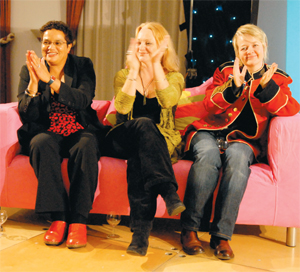Projects aimed at involving the lesbian, gay, bisexual and transgender community (LGBT) are still relatively rare, despite growing efforts to embed diversity in arts practice. AP draws together some examples and observations.Amy Bell explains how the York Lesbian Arts Festival is raising the profile of lesbian arts.

The York Lesbian Arts Festival (YLAF) started in 2000 as a small-scale literature event attended by approximately 200 people. The original intention was to profile lesbian writers and sell books for the founder of the festival, Jenny Roberts, who ran a bookshop in York. Enthusiasm for the festival from both audiences and participating artists grew every year, so in 2005 a not-for-profit organisation was formed. YLAF now runs an annual festival in York over four days and is currently seeking charitable status. YLAF 08 will feature a book festival, games night, concert, workshops and club night. Festival venues include York Racecourse, the Grand Opera House, Kings Manor and the Priory Centre.
The continued success of an arts festival dedicated to profiling the work of lesbian artists at a time when lesbians can legally adopt, get married (albeit through a civil partnership) and are protected in law from discrimination is interesting. Prominent lesbian artists and writers such as Sarah Waters, Ali Smith, Sadie Lee and Val McDermid are invited to mainstream festivals, yet lesbians are still dramatically under-represented in all the art fields, most notably at the highest levels.
YLAF programmes high quality artistic work and offers a platform to well-known artists alongside new and emerging talent. This combination makes the festival dynamic and exciting, but also allows artists to network, grow and learn from each other. Many unsigned, unpublished or less experienced artists come to the festival to take part in workshops or to meet the artists who inspire them. Performers also benefit because their profiles grow as a result of appearing at YLAF – this can help when they approach programmers at other events. The festival itself is largely staffed by volunteers or interns.
The audience at YLAF is largely drawn from the LGBT communities, but the festival welcomes everyone. The largest attendance at a single event is currently 1,000, and audience response in general has been extremely positive, perhaps because this is the only lesbian arts festival in the UK. 97% of those sampled in 2007 and 95% of those sampled in 2006 rated YLAF as ‘good’ or better, with over 50% rating it as ‘excellent’. The evaluation team is currently preparing feedback forms and this year will be asking questions about the length and location of the festival for the first time. The most successful events from 2003–2007 were the concert, club night and book festival, but numbers across all events peaked in 2005 and have been declining ever since. This could be due partly to the popularity of L-Word conferences, where people go to meet actors from the TV series ‘The L Word’ and talk about the issues raised by the programme. YLAF continues to evaluate and refine its marketing strategies since activity within the LGBT community requires a different approach to activity from other areas.
Amy Bell is a PR & Promotions Executive for Bonner and Hindley Communications
e: info@ylaf.org.uk; w: http://www.ylaf.org.uk



